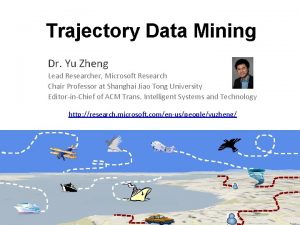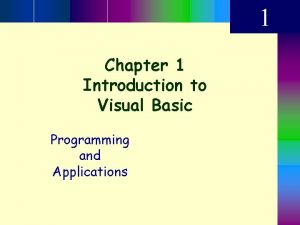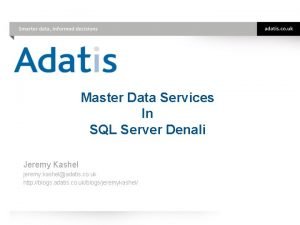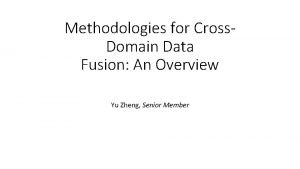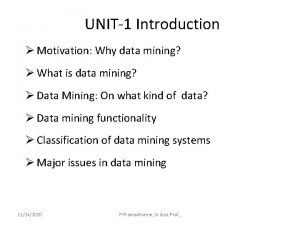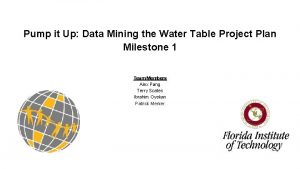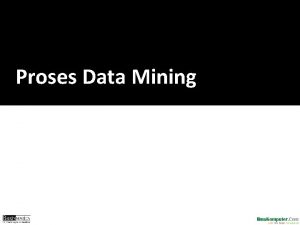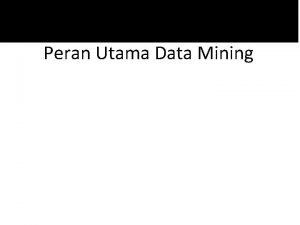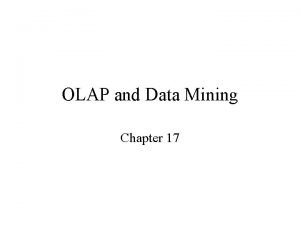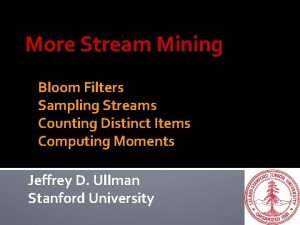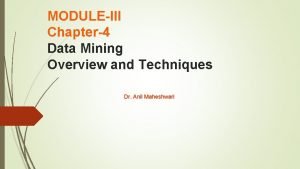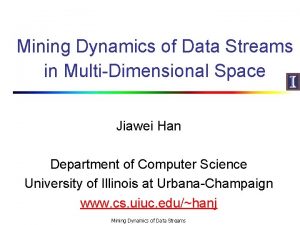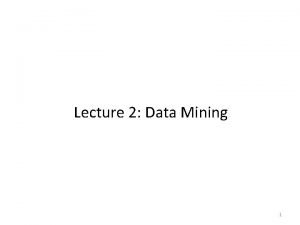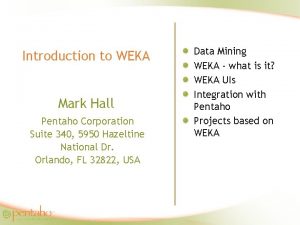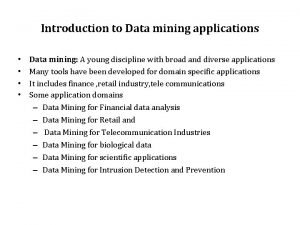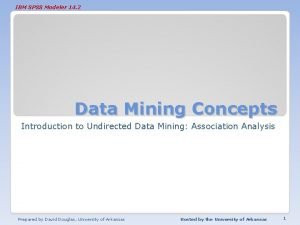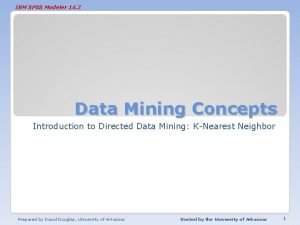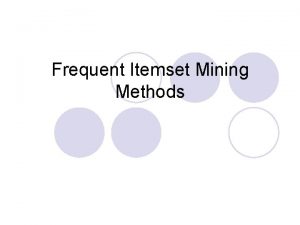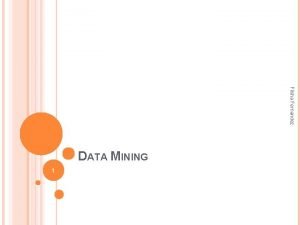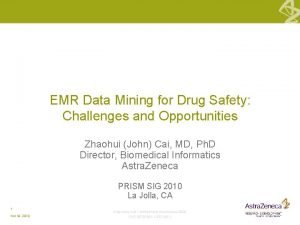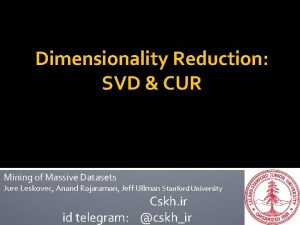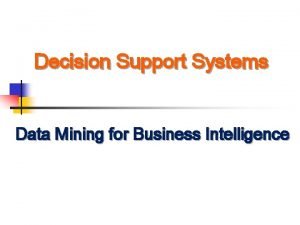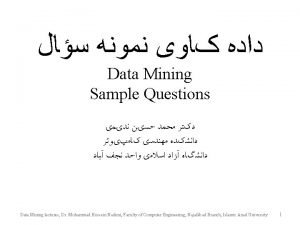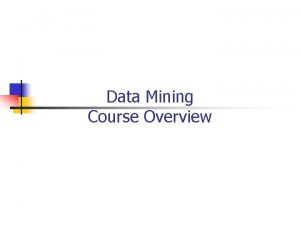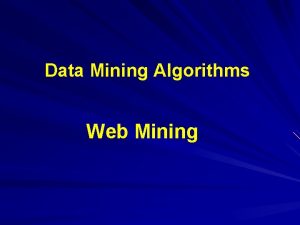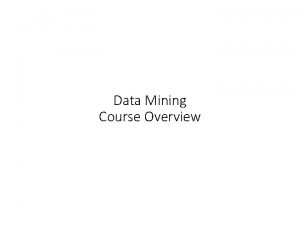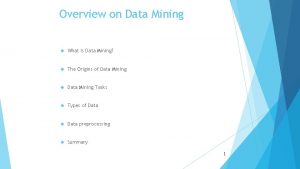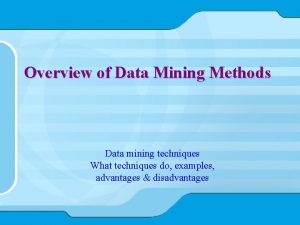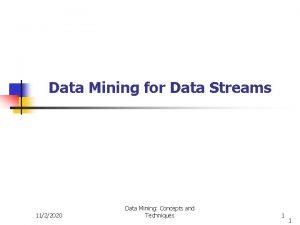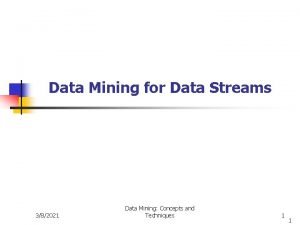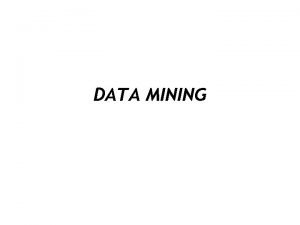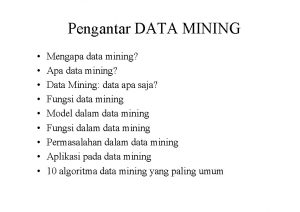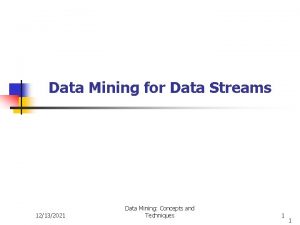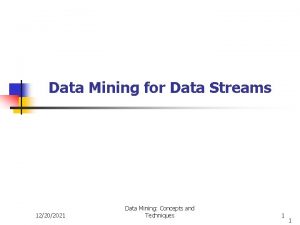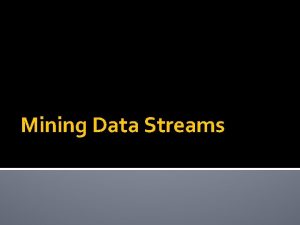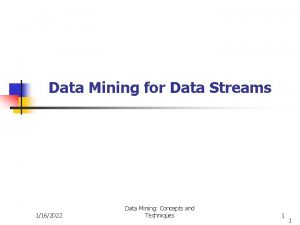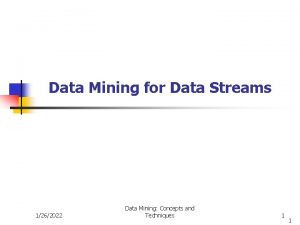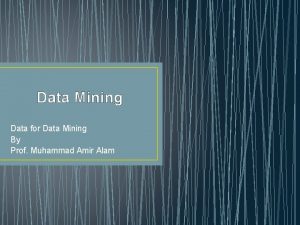Visual Data Mining An Overview n What is










![Historical Overview of Exploratory Data Visualization Techniques (cf. [WB 95]) n n n Pioneering Historical Overview of Exploratory Data Visualization Techniques (cf. [WB 95]) n n n Pioneering](https://slidetodoc.com/presentation_image/5403f684e89a35e1c8a076842ec09c11/image-11.jpg)






![Used by ermission of M. Ward, Worcester Polytechnic Institute Scatterplot-Matrices [Cleveland 93] matrix of Used by ermission of M. Ward, Worcester Polytechnic Institute Scatterplot-Matrices [Cleveland 93] matrix of](https://slidetodoc.com/presentation_image/5403f684e89a35e1c8a076842ec09c11/image-18.jpg)
![Used by permission of B. Wright, Visible Decisions Inc. Landscapes [Wis 95] n n Used by permission of B. Wright, Visible Decisions Inc. Landscapes [Wis 95] n n](https://slidetodoc.com/presentation_image/5403f684e89a35e1c8a076842ec09c11/image-19.jpg)
![Parallel Coordinates [Ins 85, ID 90] n n equidistant axes which are parallel to Parallel Coordinates [Ins 85, ID 90] n n equidistant axes which are parallel to](https://slidetodoc.com/presentation_image/5403f684e89a35e1c8a076842ec09c11/image-20.jpg)




![Dimensional Stacking [LWW 90] n n n partitioning of the n-dimensional attribute space in Dimensional Stacking [LWW 90] n n n partitioning of the n-dimensional attribute space in](https://slidetodoc.com/presentation_image/5403f684e89a35e1c8a076842ec09c11/image-25.jpg)


![Treemap [JS 91, Shn 92, Joh 93] Screen-filling method which uses a hierarchical partitioning Treemap [JS 91, Shn 92, Joh 93] Screen-filling method which uses a hierarchical partitioning](https://slidetodoc.com/presentation_image/5403f684e89a35e1c8a076842ec09c11/image-28.jpg)













![Classification (SAS EM [SAS 01]) Tree Viewer n n Color corresponds to relative frequency Classification (SAS EM [SAS 01]) Tree Viewer n n Color corresponds to relative frequency](https://slidetodoc.com/presentation_image/5403f684e89a35e1c8a076842ec09c11/image-42.jpg)
![Cluster Analysis (H-BLOB: Hierarchical BLOB) [SBG 00] Cluster Form ellipsoids Form blobs (implicit surfaces) Cluster Analysis (H-BLOB: Hierarchical BLOB) [SBG 00] Cluster Form ellipsoids Form blobs (implicit surfaces)](https://slidetodoc.com/presentation_image/5403f684e89a35e1c8a076842ec09c11/image-43.jpg)

![Text Mining (Theme. River [WCF+ 00]) n n Visualization of thematic Changes in documents Text Mining (Theme. River [WCF+ 00]) n n Visualization of thematic Changes in documents](https://slidetodoc.com/presentation_image/5403f684e89a35e1c8a076842ec09c11/image-45.jpg)
















- Slides: 61

Visual Data Mining: An Overview n What is Visual Data Mining? n Survey of techniques n Data Visualization n Visualizing Data Mining Results n Visual Data Mining

What Is Visual Data Mining? n n Visual data mining “discovers implicit and useful knowledge from large data sets using data and/or knowledge visualization techniques” Data visualization + Data mining techniques

Why Visual Data Mining? n n Advantages of human visual system n Highly parallel processor n Sophisticated reasoning engine n Large knowledge base Can be used to comprehend data distributions, patterns, clusters, and outliers Actionable Evaluation Flexibility User Interaction Data Mining Algorithms + + – – Visualization – – + +

Why Not Only Visual Data Mining? n Disadvantages of human visual system n Needs training n Not automated n Intrinsic bias n n Limit of about 106 or 107 observations (Wegman 1995) Power of integration with analytical methods

Scope of Visual Data Mining n n Visualization: Use of computer graphics to create visual images which aid in the understanding of complex, often massive representations of data Visual Data Mining: The process of discovering implicit but useful knowledge from large data sets using visualization techniques Computer Graphics High Performance Computing Multimedia Systems Pattern Recognition Human Computer Interfaces

Purpose of Visualization n Gain insight into an information space by mapping data onto graphical primitives n Provide qualitative overview of large data sets n Search for patterns, trends, structure, irregularities, relationships among data n Help find interesting regions and suitable parameters for further quantitative analysis n Provide a visual proof of computer representations derived

Visual Data Mining & Data Visualization n n Integration of visualization and data mining n data visualization n data mining result visualization n data mining process visualization n interactive visual data mining Data visualization n Data in a database or data warehouse can be viewed n at different levels of abstraction n as different combinations of attributes or dimensions n Data can be presented in various visual forms

Abilities of Humans and Computers

Visual Mining vs. Scientific Vis. & Graphics n n Scientific Visualization n Often visualize physical model, low dimensionality Graphics n More concerned with how to render (draw) rather than what to render

Data Visualization n View data in database or data warehouse n User may control n n Different levels of details n Subset of attributes Drawn using boxplots, histograms, polylines, etc.
![Historical Overview of Exploratory Data Visualization Techniques cf WB 95 n n n Pioneering Historical Overview of Exploratory Data Visualization Techniques (cf. [WB 95]) n n n Pioneering](https://slidetodoc.com/presentation_image/5403f684e89a35e1c8a076842ec09c11/image-11.jpg)
Historical Overview of Exploratory Data Visualization Techniques (cf. [WB 95]) n n n Pioneering works of Tufte [Tuf 83, Tuf 90] and Bertin [Ber 81] focus on n Visualization of data with inherent 2 D-/3 D-semantics n General rules for layout, color composition, attribute mapping, etc. Development of visualization techniques for different types of data with an underlying physical model n Geographic data, CAD data, flow data, image data, voxel data, etc. Development of visualization techniques for arbitrary multidimensional data (w. o. an underlying physical model) n Applicable to databases and other information resources

Dimensions of Exploratory Data Visualization

Classification of Data Visualization Techniques n n n Geometric Techniques: n Scatterplots, Landscapes, Projection Pursuit, Prosection Views, Hyperslice, Parallel. Coordinates. . . Icon-based Techniques: n Chernoff Faces, Stick Figures, Shape-Coding, Color Icons, Tile. Bars, . . . Pixel-oriented Techniques: n Recursive Pattern Technique, Circle Segments Technique, Spiral- & Axes. Techniques, . . . Hierarchical Techniques: n Dimensional Stacking, Worlds-within-Worlds, Treemap, Cone Trees, Info. Cube, . . . Graph-Based Techniques: n Basic Graphs (Straight-Line, Polyline, Curved-Line, . . . ) n Specific Graphs (e. g. , DAG, Symmetric, Cluster, . . . ) n Systems (e. g. , Tom Sawyer, Hy+, See. Net, Narcissus, . . . ) Hybrid Techniques: arbitrary combinations from above

Distortion & Dynamic/Interaction Techniques n Distortion Techniques n n n Simple Distortion (e. g. Perspective Wall, Bifocal Lenses, Table. Lens, Graphical Fisheye Views, . . . ) Complex Distortion (e. g. Hyperbolic Repr. Hyperbox, . . . ) Dynamic/Interaction Techniques n n n Data-to-Visualization Mapping (e. g. Auto Visual, S Plus, XGobi, IVEE, . . . ) Projections: (e. g. Grand. Tour, S Plus, XGobi, . . . ) Filtering (Selection, Querying) (e. g. Magic. Lens, Filter/Flow Queries, Info. Crystal, . . . ) n Linking & Brushing (e. g. Xmdv-Tool, XGobi, Data. Desk, . . . ) n Zooming (e. g. PAD++, IVEE, Data. Space, . . . ) n Detail on Demand (e. g. IVEE, Table. Lens, Magic. Lens, Vis. DB, . . . )

Visual Survey n Data visualization techniques n Scatterplot Matrices, Landscapes, Parallel Coordinates n Icon-based, Dimensional Stacking, Treemaps

Direct Visualization Ribbons with Twists Based on Vorticity

Geometric Techniques n n Basic Idea n Visualization of geometric transformations and projections of the data Methods n Landscapes [Wis 95] n Projection Pursuit Techniques [Hub 85] (a techniques for finding meaningful projections of multidimensional data) n Scatterplot-Matrices [And 72, Cle 93] n Prosection Views [FB 94, STDS 95] n Hyperslice [WL 93] n Parallel Coordinates [Ins 85, ID 90]
![Used by ermission of M Ward Worcester Polytechnic Institute ScatterplotMatrices Cleveland 93 matrix of Used by ermission of M. Ward, Worcester Polytechnic Institute Scatterplot-Matrices [Cleveland 93] matrix of](https://slidetodoc.com/presentation_image/5403f684e89a35e1c8a076842ec09c11/image-18.jpg)
Used by ermission of M. Ward, Worcester Polytechnic Institute Scatterplot-Matrices [Cleveland 93] matrix of scatterplots (x-y-diagrams) of the k-dimensional data [total of (k 2/2 -k) scatterplots]
![Used by permission of B Wright Visible Decisions Inc Landscapes Wis 95 n n Used by permission of B. Wright, Visible Decisions Inc. Landscapes [Wis 95] n n](https://slidetodoc.com/presentation_image/5403f684e89a35e1c8a076842ec09c11/image-19.jpg)
Used by permission of B. Wright, Visible Decisions Inc. Landscapes [Wis 95] n n news articles visualized as a landscape Visualization of the data as perspective landscape The data needs to be transformed into a (possibly artificial) 2 D spatial representation which preserves the characteristics of the data
![Parallel Coordinates Ins 85 ID 90 n n equidistant axes which are parallel to Parallel Coordinates [Ins 85, ID 90] n n equidistant axes which are parallel to](https://slidetodoc.com/presentation_image/5403f684e89a35e1c8a076842ec09c11/image-20.jpg)
Parallel Coordinates [Ins 85, ID 90] n n equidistant axes which are parallel to one of the screen axes and correspond to the attributes the axes are scaled to the [minimum, maximum]―range of the corresponding attribute every data item corresponds to a polygonal line which intersects each of the axes at the point which corresponds to the value for the attribute

Parallel Coordinates

Icon-Based Techniques n Basic Idea n n Visualization of the data values as features of icons Overview n Chernoff-Faces [Che 73, Tuf 83] n Stick Figures [Pic 70, PG 88] n Shape Coding [Bed 90] n Color Icons [Lev 91, KK 94] n Tile. Bars [Hea 95] (use of small icons representing the relevance feature vectors in document retrieval)

used by permission of G. Grinstein, University of Massachusettes at Lowell Stick Figures census data showing age, income, sex, education, etc.

Hierarchical Techniques n n Basic Idea: Visualization of the data using a hierarchical partitioning into subspaces. Overview n Dimensional Stacking [LWW 90] n Worlds-within-Worlds [FB 90 a/b] n Treemap [Shn 92, Joh 93] n Cone Trees [RMC 91] n Info. Cube [RG 93]
![Dimensional Stacking LWW 90 n n n partitioning of the ndimensional attribute space in Dimensional Stacking [LWW 90] n n n partitioning of the n-dimensional attribute space in](https://slidetodoc.com/presentation_image/5403f684e89a35e1c8a076842ec09c11/image-25.jpg)
Dimensional Stacking [LWW 90] n n n partitioning of the n-dimensional attribute space in 2 dimensional subspaces which are ‘stacked’ into each other partitioning of the attribute value ranges into classes the important attributes should be used on the outer levels adequate especially for data with ordinal attributes of low cardinality

Dimensional Stacking Visualization of oil mining data with longitude and latitude mapped to the outer x-, y-axes and ore grade and depth mapped to the inner x-, y-axes Used by permission of M. Ward, Worcester Polytechnic Institute

Dimensional Stacking n Disadvantages: n Difficult to display more than nine dimensions n Important to map dimensions appropriately n May be difficult to understand visualizations at first
![Treemap JS 91 Shn 92 Joh 93 Screenfilling method which uses a hierarchical partitioning Treemap [JS 91, Shn 92, Joh 93] Screen-filling method which uses a hierarchical partitioning](https://slidetodoc.com/presentation_image/5403f684e89a35e1c8a076842ec09c11/image-28.jpg)
Treemap [JS 91, Shn 92, Joh 93] Screen-filling method which uses a hierarchical partitioning of the screen into regions depending on the attribute values The x- and y-dimension of the screen are partitioned alternately according to the attribute values (classes) MSR Netscan image:


Treemap of a File System (Schneiderman)

Treemaps n n n The attributes used for the partitioning and their ordering are user-defined (the most important attributes should be used first) The color of the regions may correspond to an additional attribute Suitable to get an overview over large amounts of hierarchical data (e. g. , file system) and for data with multiple ordinal attributes (e. g. , census data)

Data Mining Result Visualization n n Presentation of the results or knowledge obtained from data mining in visual forms Examples n Scatter plots and boxplots (obtained from descriptive data mining) n Decision trees n Association rules n Clusters n Outliers n Generalized rules n Text mining

Boxplots from Statsoft: Multiple Variable Combinations

Visualization of Data Mining Results in SAS Enterprise Miner: Scatter Plots

Visualization of Association Rules in SGI/Mine. Set 3. 0

Visualization of Decision Tree in SGI/Mine. Set 3. 0

Vizualization of Decision Trees

Visualization of Cluster Grouping IBM Intelligent Miner

Association Rules (Mine. Set) n n n LHS and RHS items are mapped to x-, y-axis Confidence, support correspond to height of the bar or disc, respectively Interestingness is mapped to Color

Mine. Set: Association Rules

Association Ball Graph (DBMiner) n n n Items are visualized as balls Arrows indicate rule implication Size represents support
![Classification SAS EM SAS 01 Tree Viewer n n Color corresponds to relative frequency Classification (SAS EM [SAS 01]) Tree Viewer n n Color corresponds to relative frequency](https://slidetodoc.com/presentation_image/5403f684e89a35e1c8a076842ec09c11/image-42.jpg)
Classification (SAS EM [SAS 01]) Tree Viewer n n Color corresponds to relative frequency of a class in a node Branch line thickness is proportional to the square root of the objects
![Cluster Analysis HBLOB Hierarchical BLOB SBG 00 Cluster Form ellipsoids Form blobs implicit surfaces Cluster Analysis (H-BLOB: Hierarchical BLOB) [SBG 00] Cluster Form ellipsoids Form blobs (implicit surfaces)](https://slidetodoc.com/presentation_image/5403f684e89a35e1c8a076842ec09c11/image-43.jpg)
Cluster Analysis (H-BLOB: Hierarchical BLOB) [SBG 00] Cluster Form ellipsoids Form blobs (implicit surfaces)

H-BLOB
![Text Mining Theme River WCF 00 n n Visualization of thematic Changes in documents Text Mining (Theme. River [WCF+ 00]) n n Visualization of thematic Changes in documents](https://slidetodoc.com/presentation_image/5403f684e89a35e1c8a076842ec09c11/image-45.jpg)
Text Mining (Theme. River [WCF+ 00]) n n Visualization of thematic Changes in documents Vertical distance indicates collective strength of themes

Data Mining Process Visualization n Presentation of the various processes of data mining in visual forms so that users can see the flow of data cleaning, integration, preprocessing, mining n Data extraction process n Where the data is extracted n How the data is cleaned, integrated, preprocessed, and mined n Method selected for data mining n Where the results are stored n How they may be viewed

Visualization of Data Mining Processes by Clementine See your solution discovery process clearly Understand variations with visualized data

Interactive Visual Data Mining n n Using visualization tools in the data mining process to help users make smart data mining decisions Example n n Display the data distribution in a set of attributes using colored sectors or columns (depending on whether the whole space is represented by either a circle or a set of columns) Use the display to which sector should first be selected for classification and where a good split point for this sector may be

Visual data mining n n n Projection Pursuits (Class) Tours [Dhillon et al. ’ 98] Visual Classification [Ankerst et al. KDD ’ 99]

Projection Pursuits n Exploratory projection pursuit: n Goal: reduce dimensionality n Define “interestingness” index to each possible projection of a data set n Maximize this index, project linearly n Not always possible/useful

Class Tours n n n “Visualizing Class Structure of Multidimensional Data” by Dhillon et al. 1998 Problem: Visualize multidimensional data categorized into classes Solution: Project data into 2 D while preserving distances between class means

Class-Preserving Projection: Preserves distances between projected means

Tours n n n Tours are animated and interpolated sequences of 2 D projections [Asimov 1985] Class tours: sequences of class-preserving 2 dimensional projections Captures “inter-class structure of complex, multidimensional data”

Interactive Visual Mining by Perception-Based Classification (PBC)

Visual Classification n n “Visual Classification: An Interactive Approach to Decision Tree Construction” by Ankerst et al. KDD 99 Exploit expert’s domain knowledge and human visual processing

Visual Classification

Visual Classification Results n n n Comparable classification accuracy Can produce more understandable decision trees Expert domain knowledge can be exploited

Audio Data Mining n Uses audio signals to indicate the patterns of data or the features of data mining results n n An interesting alternative to visual mining An inverse task of mining audio (such as music) databases which is to find patterns from audio data Visual data mining may disclose interesting patterns using graphical displays, but requires users to concentrate on watching patterns Instead, transform patterns into sound and music and listen to pitches, rhythms, tune, and melody in order to identify anything interesting or unusual

Summary n n n Many visualization methods available How to evaluate and compare methods? Need for: n Integrated visualization/exploration systems n Studies of interaction techniques for mining n Practical case studies

Acknowledgments n n n Many slides and images from Mihael Ankerst, Boeing, Daniel A. Keim, AT&T, Tutorial at PKDD'2001 Some pictures from Information Visualization in Data Mining and Knowledge Discovery, edited by Usama Fayyad, Georges Grinstein and Andreas Wierse A good set of slides were prepared by Andrew Wu (Spring 2004)

 Mining complex types of data in data mining
Mining complex types of data in data mining Trajectory data mining an overview
Trajectory data mining an overview Multimedia data mining
Multimedia data mining Dbminer
Dbminer Strip mining vs open pit mining
Strip mining vs open pit mining Strip mining vs open pit mining
Strip mining vs open pit mining Difference between strip mining and open pit mining
Difference between strip mining and open pit mining Difference between text mining and web mining
Difference between text mining and web mining Data cleaning problems and current approaches
Data cleaning problems and current approaches Data quality and data cleaning an overview
Data quality and data cleaning an overview Data quality and data cleaning an overview
Data quality and data cleaning an overview Data reduction in data mining
Data reduction in data mining What is data mining and data warehousing
What is data mining and data warehousing What is missing data in data mining
What is missing data in data mining Data reduction in data mining
Data reduction in data mining Data reduction in data mining
Data reduction in data mining Data reduction in data mining
Data reduction in data mining Data cube technology in data mining
Data cube technology in data mining Data reduction in data mining
Data reduction in data mining Arsitektur data mining
Arsitektur data mining Data mining dan data warehouse
Data mining dan data warehouse Datamart olap
Datamart olap Complex data types in data mining
Complex data types in data mining Data warehousing olap and data mining
Data warehousing olap and data mining Noisy data in data mining
Noisy data in data mining 3 tier architecture of data warehouse
3 tier architecture of data warehouse Data preparation for data mining
Data preparation for data mining Data compression in data mining
Data compression in data mining Introduction to data warehousing and data mining
Introduction to data warehousing and data mining Data warehouse dan data mining
Data warehouse dan data mining Complex data types in data mining
Complex data types in data mining Intro to visual basic
Intro to visual basic Master data services overview
Master data services overview Master data services overview
Master data services overview Chicago time
Chicago time An overview of data warehousing and olap technology
An overview of data warehousing and olap technology Methodologies for cross-domain data fusion: an overview
Methodologies for cross-domain data fusion: an overview Pengertian pemrograman visual
Pengertian pemrograman visual Unsupervised learning in data mining
Unsupervised learning in data mining Motivation for data mining
Motivation for data mining Data mining concepts and techniques slides
Data mining concepts and techniques slides Reporting and query tools in data mining
Reporting and query tools in data mining Pump it up: data mining the water table
Pump it up: data mining the water table Tahapan utama proses data mining
Tahapan utama proses data mining Peranan utama data mining
Peranan utama data mining Oltp stands for in data mining
Oltp stands for in data mining Bloom filter for stream data mining
Bloom filter for stream data mining Data mining steps
Data mining steps Data mining exam
Data mining exam Multidimensional space in data mining
Multidimensional space in data mining Data mining roadmap
Data mining roadmap Weka pentaho
Weka pentaho Spatial data mining applications
Spatial data mining applications Walmart data mining
Walmart data mining Data mining spss
Data mining spss Spss data mining
Spss data mining Mining frequent itemsets using vertical data format
Mining frequent itemsets using vertical data format Gini index
Gini index Emr data mining
Emr data mining Cur decomposition in data mining
Cur decomposition in data mining Dss in data mining
Dss in data mining 6-8-10 square rule
6-8-10 square rule

